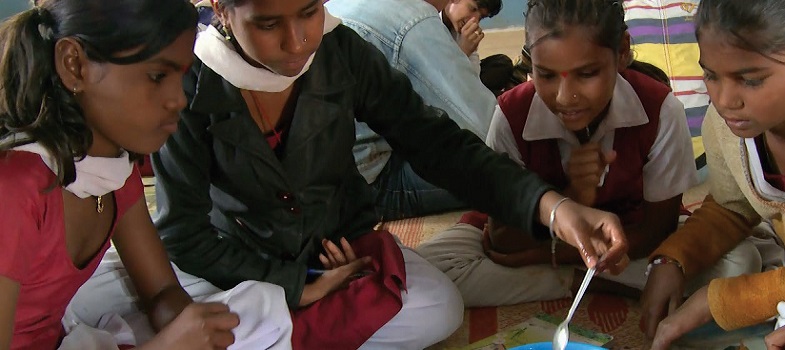2 Reading and decoding word problems

‘Reading’ word problems involves ‘decoding’ the information in order to understand what the mathematical model is and therefore what ideas are needed to provide a solution. Some word problems contain irrelevant information and others do not. It is important to train your students’ minds to spot the relevance (or degree of relevance) of mathematical information in a word problem.
The very first step in this process involves the student scanning the problem to identify key words. The student then has to decide which information is relevant or irrelevant. The student then moves on to reorganise the word problem into smaller parts to start solving the problem. Some of your students may not always understand all the words in a word problem, particularly if it is not written in their first language. You will need to give them confidence to try the maths problem, even if they are not always sure of all the Hindi or English words.
In Activity 1 your focus is on training the mind of your students to spot relevant information and then to work at ‘chunking’ the word problems into smaller parts. This activity works particularly well when students work in pairs or small groups.
Before attempting to use the activities in this unit with your students, it would be a good idea to complete all (or at least part) of the activities yourself. It would be even better if you could try them out with a colleague, as that will help you when you reflect on the experience. Trying the activities yourself will mean that you get insights into learners’ experiences that can in turn influence your teaching and your experiences as a teacher. When you are ready, use the activities with your students. After the lesson, think about the way that the activity went and the learning that happened. This will help you to develop a more learner-focused teaching environment.
Activity 1: Key words and chunking problems
Tell your students to work with one or two other students. Make sure that every student has someone to work with. Then tell your students to read each word problem below and make a list of the key words or phrases that can help them solve the problem. They should then set out the problems in simpler chunks of information.
- A square garden has a walking track that is eight feet wide along its sides. If one side of the garden is ten metres long, find the distance travelled by Hamid if he walks around the garden twice.
- Kavita was given some money on her 16th birthday by her uncle. She used the money to buy two pairs of jeans for Rs. 950 each from a store that was offering a 20 per cent discount. After the purchase, she still had Rs. 150 left. How much money did her uncle give her?
Figure 2 A row of jeans.
- Rita buys 3 kg of mangos and 12 bananas for Rs. 280 on Tuesday. Three days later, from the same shop, Rahul buys 2 kg of mangos and 18 bananas for Rs. 300. Write the equations that can help find the cost of 1 kg of mangos and a dozen bananas.
When they have completed this, tell your students to answer these questions:
- For each key word or phrase you think is useful, provide your reason why.
- What helped you decide which numerical data was useful and which was not? Did you miss any useful information?
- Was there some information that you found difficult to classify as ‘useful’ or ‘not useful’? How did you go about accepting or rejecting this information?
- What did you find easy or difficult about chunking a word problem into smaller pieces of information?
- Did you visualise any of the above problems before identifying key words or chunking? How was visualising helpful?
Before the end of the lesson, ask the students to bring together their answers and try to jointly construct good general ideas on how to solve these types of problems.
Case Study 1: Mrs Chakrakodi reflects on using Activity 1
This is the account of a teacher who tried Activity 1 with her secondary students.
My class has found using word problems very difficult. The students like to answer mathematics questions quickly and get lots done, and word problems always slow them down. Since being able to answer word problems is so important in examinations, I decided to spend some time helping my students learn to solve them. First I asked them what skills they needed when solving word problems. They could not answer at first, so I asked them to discuss the question in pairs. Their answers were that you have to:
- read the problem carefully
- recognise what is the context and what is important for solving the mathematics
- note down important words, numbers and information, perhaps on a diagram
- ignore irrelevant words and numbers
- think what mathematics must be used to solve it, then use it
- check and decide whether the answer makes sense
- give the answer in a way that relates it to the problem asked – for example, using appropriate units of measurement.
I then asked the class to look at the problems in Activity 1. They wanted just to answer the problems, but I wanted them to think about the process and use the problem solving skills we had come up with. So we looked together at the second question of Kavita going shopping for jeans.
First I asked them to chunk the information. We came up with the following chunks of important information:
- Kavita was given some money.
- She bought two pairs of jeans.
- Each pair of jeans cost Rs. 950.
- She still had Rs. 150.
- How much money did her uncle give her?
Then we looked at the mathematics involved at each step. I asked the class to come up with the meaning of each word or phrase, and the mathematical meaning it is trying to convey. I had to help them with the first one, but after that they got the idea:
- ‘Kavita was given some money.’ This is the ‘unknown’ – say, x.
- ‘She buys two pairs of jeans.’ Whatever she spent has to be subtracted from x.
- ‘Each pair of jeans cost Rs. 950.’ So she spent 2 × 950 = Rs. 1900.
- ‘She still had Rs. 150.’ This should be x – 1900.
- ‘How much money did her uncle give her?’ This is x.
Once we had done this, the students tackled the other two word problems in the same way, chunking them and trying to write down the mathematical expressions for what they were doing. They realised fairly soon that to answer the first question they needed to know where Hassan was walking on the path, and that the measurements were in feet and metres, so some conversion would be needed. The third question also resulted in a debate over whether it mattered that the two visits to the shop were three days apart, so we talked about irrelevant information in word problems.
For homework I asked the students to have some fun devising word problems of their own that contained some good mathematics and some irrelevant information that was not obvious.
Read Resource 2, ‘Using pair work’, for more ideas.
Reflecting on your teaching practice
When you do such an activity with your class, reflect afterwards on what went well and what went less well. Consider the questions that led to the students being interested and being able to get on, and those where you needed to clarify. Such reflection always helps with finding a ‘script’, which helps you engage the students to find mathematics interesting and enjoyable. If they do not understand and cannot do something, they are less likely to become involved. Use this reflective exercise every time you undertake the activities, noting as Mrs Chakrakodi did some quite small things that made a difference.
Pause for thought Good questions to trigger such reflection are:
|
1 Issues with word problems

